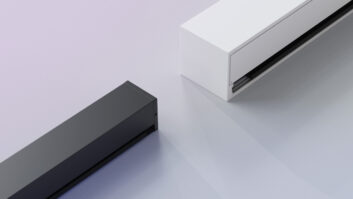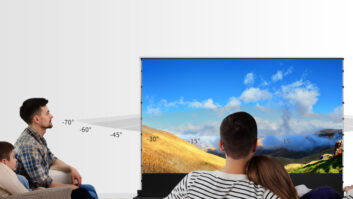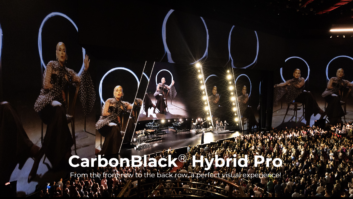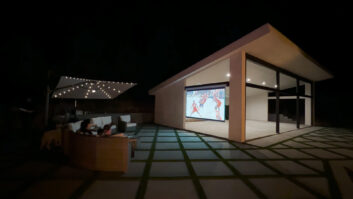Let’s face it. Most projection screens are boring. They consist of a flat white (or gray or silver) surface, which has a sole purpose of reflecting light from the magic maker (the projector). While absolutely important, they’re not, as the marketing people would say, “sexy.” Screens that don’t lay flat on a wall are designed to roll up and out of the way, invisible until needed.

In the simplest install, Screen Innovations’ Zero Edge hangs slightly off the wall, just as a flat-panel TV would.
Not so with the Black Diamond Zero Edge from Screen Innovations. Here we have a screen created to add something to a room. It’s a screen with a simple, yet clever, design that actually inspires you to show it off, like a stylish new flat panel, rather than hide it away.
That’s probably the comparison that fits best, one of a flat panel. Indeed, Screen Innovations clearly was going for a flat-panel aesthetic, with a thin black bezel around a dark screen. The unknowing may walk into a room with the Zero Edge and ask what type of “TV” it is.
The installation encourages this illusion. In the simplest install, the Zero Edge hangs slightly off the wall, just as a flat-panel TV would. Being a rigid screen, once you drill the two wall mounts into studs, you hang the Zero Edge like a painting. Done. My 92-inch review sample was light enough that I could do this myself, though SI explicitly recommends two people. Chalk this up to the huge muscles I have thanks to sitting at a desk and typing all day. Or not.
Two other install options are possible. The Zero Edge can be mounted flush with a wall. The other, even more high-tech option, is hanging it from the ceiling so it appears to float in the air. Regardless of its location, one thing to keep in mind when mounting the screen is the location of the projector. Zero Edge, like most screens today, is angular reflective, so if the projector is mounted above your head, the brightest image will be roughly where you’re sitting. If the projector is on a shelf behind you, the brightest image may be best seen by your feet.
The Zero Edge comes in three screen gains: 0.8, 1.4, and 2.7. Most new projectors have a pretty decent black level and contrast ratio, so “negative gain” screens like a 0.8 in my mind only serve to limit max screen size. They’re also quite bright, so 2.7 seems excessive to me, but I could see its use in a bright room or really large screen.
I found the 1.4 of my review sample to offer lots of additional punch over my reference 1.0 gain screen. However, like all higher gain screens, there are two drawbacks: hotspotting/uniformity, and sparkle. The center of the screen is visibly brighter than the edges. This is especially noticeable in outside scenes where there’s a lot of sky. Sparkle is, well, a sparkly texture to bright images. I’ve seen far worse (namely, any RPTV), but it’s worth noting. To be honest, I found both of these aspects to be reasonable given the coolness of Zero Edge overall.
The biggest benefit, beyond the cool design, is the Black Diamond material, essentially a black surface with a reflective quality. The idea is to focus the light from the projector, while rejecting or absorbing light from other sources (like room lighting). Of course, having the lights on in the room degraded the picture, but to far less an extent than my normal white screen. Opening the curtains in my theater, a terrifying view of the real world momentarily paralyzed me. Also, sunlight entered. On my 1.0-gain screen you could sort of make out the brightest parts of the image, though most was left to the imagination. On the Zero Edge, there was an actual image. The darkest parts of the picture were still washed out, but it was watchable. That’s pretty impressive for projection.
For an extra $499, you can equip your Zero Edge with LED lighting that resides in the metal frame mount. These LEDs aim outward, adding color to your wall, or some classy indirect white lighting. A handy remote lets you dial in an exact amount of red, green, or blue for whatever color you want. The “white” preset is a bit bluish for my tastes, but a bit of fiddling got a warm color temp that I saved as one of the seven presets. There’s also music mode that pulses to whatever audio it hears.
With any screen designed for use in a room, with the lights on, and to look good even when the projector is off, there are going to be compromises. If your goal is perfect picture projection, well I bet you stopped reading paragraphs ago. The goal of the Zero Edge is to provide the ability to add a projector into a real-world room, supplanting a tiny flat-panel for a massive screen, and to look stylish doing it. Viewed with that perspective, the Zero Edge is a fantastically cool product.
512.832.6939 www.screeninnovations.com
Kudos
Clever flat-panel aesthetic adds a bit of style potential to a traditionally boring product category. Usable with the lights on.
Concerns
Adds a bit of sparkle to bright images. Brightness uniformity is inconsistent.
Product Specs
• A vailable in 0.8, 1.4, and 2.7 gain configurations
• Up to 115-inch (16:9) or 144-inch diagonal (2.35:1)
• Mountable on-wall, inwall or hung from ceiling
• Black Diamond material rejects some ambient light
• Optional LED Backlighting Kit







